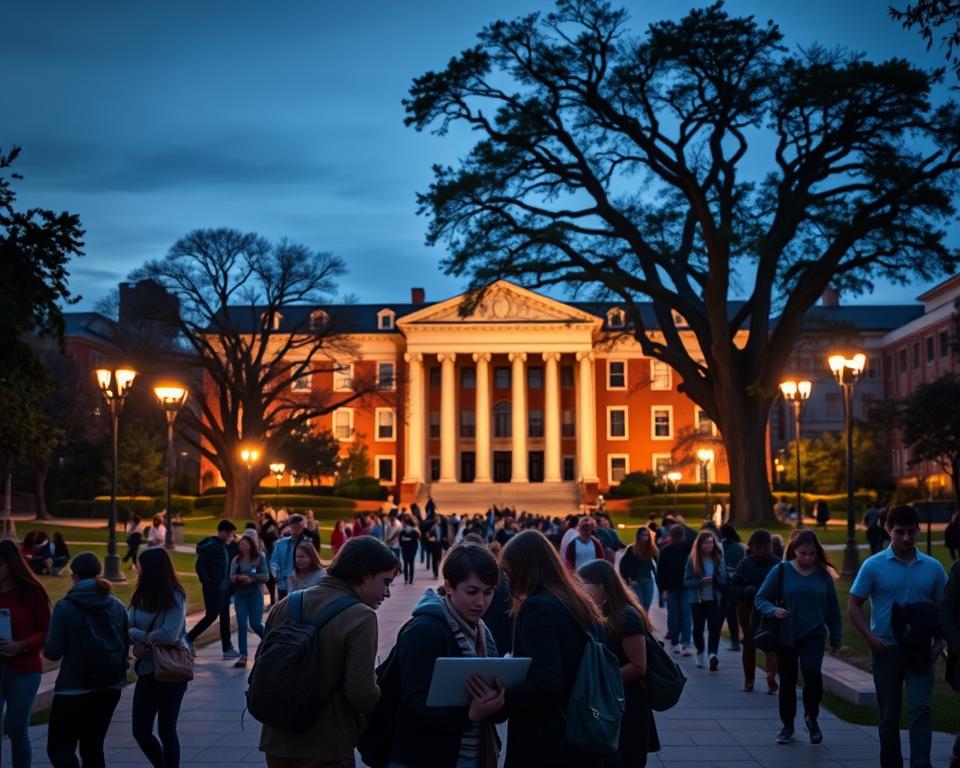Anúncios
Aplicações pode parecer assustador, mas alguns hábitos simples podem impedir o pânico e os erros de última hora?
Você estabelecerá um ritmo tranquilo para o ciclo de admissões de 2025-2026 ao combinar testes, redações e recomendações com datas disponíveis. A Ação Antecipada e a Decisão Antecipada geralmente ocorrem no início de novembro, enquanto a Decisão Regular ocorre no início de janeiro. Conhecer essas janelas ajuda você a planejar o ACT/SAT, os rascunhos e as solicitações para não ter que correr atrás.
Use um calendário compartilhado e um hub de documentos para que cada formulário de inscrição, histórico escolar e solicitação seja fácil de encontrar. Pequenos cheques semanais e rascunhos iniciais eliminam erros. Além disso, equilibre velocidade e prontidão: aplicar com antecedência pode resultar em decisões mais rápidas, mas somente se o seu arquivo estiver completo.
Verifique as páginas das faculdades para saber os prazos exatos de inscrição e os prazos de auxílio antes de enviar. Experimente ferramentas que você realmente usará, não um aplicativo único, e sempre confirme as datas em sites oficiais.
Os maiores erros de prazo que atrapalham as inscrições para a faculdade
Uma única confusão no prazo pode custar opções de admissão ou auxílio. Abaixo estão os erros comuns e soluções claras para que você termine no prazo.
Interpretação incorreta dos tipos de aplicação
Não confunda decisão antecipada e ação antecipada. A decisão antecipada é vinculativa; a ação antecipada geralmente não é. Algumas escolas oferecem medidas antecipadas restritivas que limitam outros planos antecipados. Faça isto: marque quais escolas são vinculativas antes de clicar em enviar.
Janelas principais ausentes
A maioria das faculdades define janelas de inscrição para o núcleo: 1 a 15 de novembro para planos iniciais e 1 a 15 de janeiro para decisões regulares. Perder esses prazos de inscrição para a faculdade pode levá-lo a rodadas posteriores ou a períodos diferentes. Adicione um prazo interno flexível de uma semana para evitar problemas técnicos.
Supervisionar cronogramas de programas e transferências
Cursos de especialização costumam ter datas separadas para portfólios, audições ou auxílios prioritários. Verifique a página de cada escola e liste todos os prazos dos programas em um único calendário.
Não sincronizar testes, ensaios e recomendações
- Crie de trás para frente a partir das datas de decisão: bloqueie redações e cartas de recomendação pelo menos duas semanas antes dos períodos de envio.
- Inscreva-se para os testes com antecedência início do último ano então as pontuações chegam antes decisão regular prazos.
- Confirme se a faculdade deseja que os itens sejam “enviados até” ou “concluídos até” para evitar surpresas.
- Evite isso: assumindo que admissões contínuas significam que você pode esperar.
- Faça isto: inscreva-se com antecedência nas escolas rotativas para garantir vagas e fundos de mérito.
Candidaturas 2025: cronogramas, decisões e sincronização de auxílio financeiro
Fixe seu cronograma em algumas datas fixas para evitar correrias de última hora e oportunidades perdidas. Abaixo está um plano simples que alinha testes, redações e auxílios para que seu arquivo esteja completo quando as escolas o revisarem.
Principais intervalos de datas e pontos de verificação
As janelas de EA/ED ocorrem no início de novembro (1 a 15 de novembro) e produzem decisões por volta de meados de dezembro. As janelas de decisão regulares ocorrem de 1 a 15 de janeiro, com resultados de meados de março a início de abril.
Como o cronograma do FAFSA afeta a ajuda
Envie o FAFSA com antecedência para atender aos períodos de auxílio prioritário em muitas faculdades. O envio antecipado melhora o acesso a bolsas de estudo e programas de trabalho e estudo, além de ajudar os escritórios de auxílio financeiro a produzirem os pacotes em tempo hábil.
Atualização do Common App e admissões diretas
O Common App foi inaugurado em 1º de agosto e adicionou um caminho de admissão direta com mais de 200 parceiros. Essa rota pode acelerar as ofertas, mas sempre compare a adequação do programa e os pacotes de auxílio antes de aceitar.
Escolhas estratégicas: antecipar vs. esperar
- Inscreva-se com antecedência se seu perfil estiver pronto, isso pode aumentar um pouco as chances.
- Espere se as notas do semestre de outono ou uma repetição do teste forem fortalecidas para você; envie em janeiro, quando seu histórico estiver mais forte.
- Use meados de outubro como ponto de verificação final para pontuações, transcrições e uploads de recomendações para que os prazos de decisão sejam cumpridos sem problemas.
Erros de organização e as ferramentas que os corrigem
Um cronograma limpo e um hub central de arquivos tornam o processo de inscrição mais factível. Comece mapeando cada prazo e dividindo o trabalho em semanas para que nada se acumule no último mês.
Crie um cronograma e calendário limpos com lembretes
Use o Google Agenda para criar uma visualização semestral e codificar cada faculdade por cores. Defina dois lembretes por data: um uma semana antes e outro 48 horas antes dos prazos oficiais.
Datas internas suaves uma semana antes, protege você de interrupções no portal, erros de upload ou uma carta de recomendação atrasada.
Centralizando documentos: transcrições, ensaios e cartas de recomendação
Mantenha os arquivos no Google Drive ou Dropbox com pastas claras: Escola > Período > Tipo de Documento. Isso torna históricos escolares, redações, notas de testes e cartas de recomendação fáceis de encontrar.
- Acompanhe tarefas com Trello ou Notion: Para fazer, Rascunho, Enviado, Acompanhamento.
- Use o Todoist ou o Evernote para listas de verificação diárias para que você possa escrever redações ao longo do ano.
- Dê aos recomendantes do ensino médio uma folha de uma página com suas informações, sua lista de atividades e defina as datas com antecedência para facilitar a escrita de cartas de recomendação fortes.
Confirme os requisitos exatos de cada escola e o status do portal nos sites oficiais. Revise os portais de envio semanalmente durante as semanas de pico para que seu arquivo seja exibido como completo bem antes do fim dos prazos.
Inscrições tardias e admissões contínuas: atitudes inteligentes quando você está atrasado
Quando os prazos se aproximam, revisão contínua As escolas oferecem um caminho prático de volta ao processo. Você ainda pode se inscrever em muitas faculdades que aceitam inscrições até o final da primavera e o verão para o semestre de outono.

Por que rolar ajuda: Essas escolas analisam os processos à medida que chegam e, muitas vezes, emitem uma decisão em semanas. Essa rápida resposta pode garantir uma vaga enquanto outros campi preenchem as vagas.
“Inscreva-se antes da data final — os prazos prioritários são importantes para auxílio e moradia.”
Opções reais por mês: abril ainda lista a Universidade de Nevada Reno e a Universidade de Pittsburgh; 1º de maio abre a Universidade do Arizona e a UCF; junho inclui a Universidade Loyola Chicago e a UNC Charlotte; julho e agosto hospedam campi como UMass Boston, Portland State e West Virginia University.
- Priorize as admissões contínuas para obter uma decisão mais rápida.
- Respeite os prazos prioritários para auxílio financeiro, moradia e cursos populares.
- Use os filtros do Common App para encontrar escolas que aceitam inscrições após sua data e entre em contato com o departamento de admissões para confirmar os prazos e janelas de auxílio.
Sprint de duas semanas: Conclua as redações, solicite as transcrições restantes, envie e verifique os portais diariamente até que seu arquivo seja considerado concluído. Sempre verifique os prazos de inscrição para a faculdade nos sites oficiais das escolas antes de clicar em enviar.
Conclusão
Conclusão
Concentre-se no progresso constante para enviar inscrições completas e competitivas para a faculdade no prazo.
Concentre seu plano no padrão principal: decisão antecipada e ação antecipada em novembro, e decisão regular em janeiro. Mantenha as etapas do FAFSA e do auxílio financeiro na mesma lista de verificação para que você possa comparar as ofertas quando as decisões chegarem. Se o seu perfil estiver pronto, inscreva-se com antecedência; caso contrário, busque o período de janeiro e apresente notas e atividades mais fortes.
Use seu orientador escolar, as páginas oficiais de admissão em faculdades e sites federais para confirmar datas e requisitos específicos. Divida as tarefas em etapas semanais, monitore os portais de perto e crie reservas internas. Com hábitos estáveis, os prazos se encaixam e você terá muitas opções sólidas quando as decisões finais chegarem.



